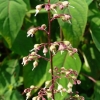Features
Large leaves, which are dark purple/green on top and a more pinky purple underneath, borne on long petioles, form clumps of evergreen foliage. In summer tall flower spikes arise from the clumps with tiny cream coloured flowers.
What to use it for
Great in beds and borders where it makes attractive year round ground cover or edging. Can be used to underplant shrubs and roses. Grows happily in containers and the leaves last well in cut flower arrangements.
How to look after it
The woody crown tends to rise above ground level over winter; mulching in autumn may prevent this or lifting and replanting in spring will cover them back up. Heucheras benefit from being divided every few years to maintain their vigour and leaf colour (see ‘how to propagate it’ below).
How to prune it
Remove the spent flower spikes after flowering. If the leaves become tatty then they can be removed (cut them off at the base), retaining some foliage.
How to propagate it
Divide plants in spring or autumn, using sections from around the outside of the woody crown (which are younger) and discarding the older centre. Each section should have a good root system attached and 2 to 3 shoots.
Seeds can be sown in spring and germinated at 10°C. Seeds from cultivars may not come true to type, but you may well get some interesting variations!
Common problems
May be infested by vine weevils and leaf eelworms. Leafy gall can also be a problem.
Other useful information?
The genus Heuchera was named after the German botanist Johann Heinreich Heucher (1677–1747).
The roots of Heuchera americana (one of the original species from which many cultivars have been hybridised) was used by native North Americans as a healing herb for treating ailments including dysentery, wounds and sore throats.
This heuchera has been given the Award of Garden Merit by the RHS.







